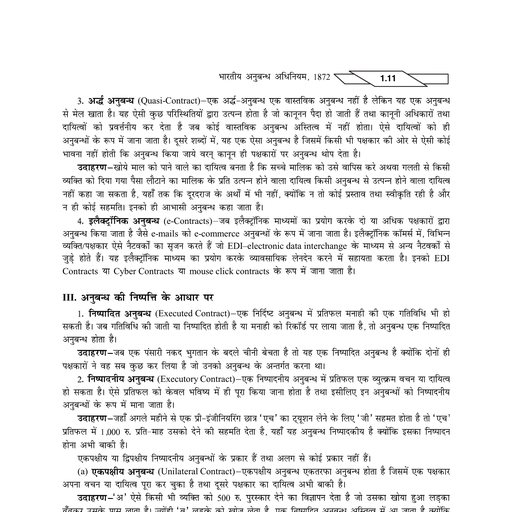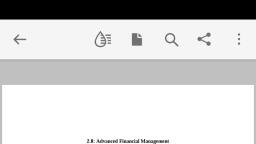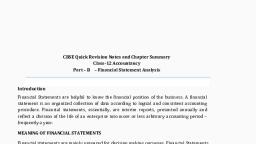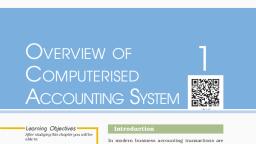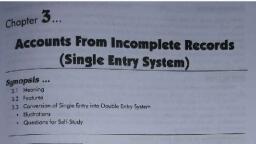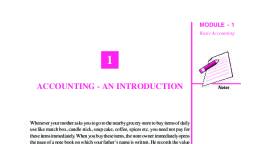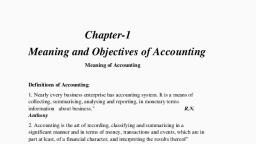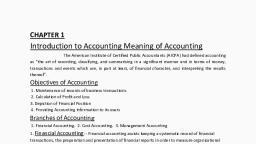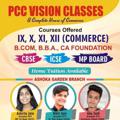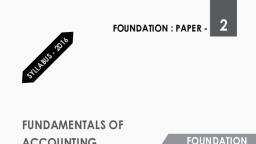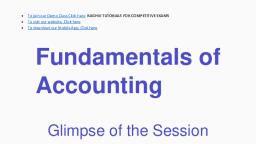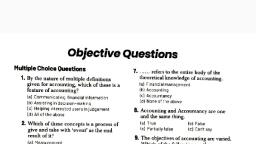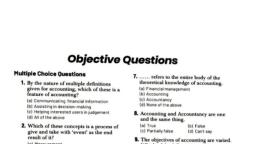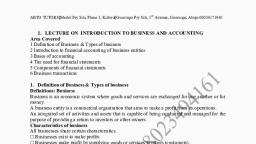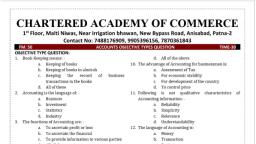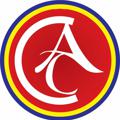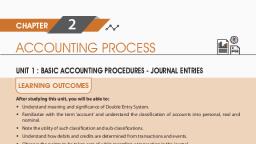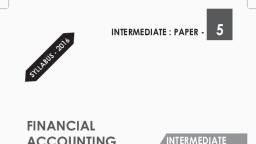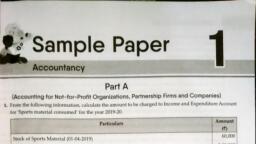Page 1 :
Introduction to Accounting, Short Answer Type Questions, Q1. Define accounting., Answer : Accounting is a process of identifying the events of financial nature, recording them, in Journal, classifying in their respective ledgers, summarising them in Profit and Loss Account, and Balance Sheet and communicating the results to the users of such information, viz., owner/s, government, creditors, investors etc., According to the American Institute of Certified Accountants, 1941, “Accounting is an art of, recording, classifying and summarising in a significant manner and in terms of money, transactions and events that are, in part at least, of a financial character and interpreting the, results thereof.”, Q2. State what is end product of financial accounting?, Answer :, , Income statements (Trading and/or Profit and Loss Account)- An income statement that, includes Trading and Profit and Loss Account, ascertains the financial results of a business in, terms of gross (or net) profit or loss., Balance Sheet- It depicts the true financial positions of a business that provides required, information like assets and liabilities of a business firm, to the users of accounting information, like owners, creditors, investors, government, etc., Q3. Enumerate main objectives of accounting., Answer :1. The main objectives of accounting are given below.
Page 2 :
2. To keep a systematic record of all business transactions, 3. To determine the profit earned or loss incurred during an accounting period by preparing, profit and loss account, 4. To ascertain the financial position of the business at the end of each accounting period by, preparing balance sheet, 5. To assist management for decision making, effective control, forecasting, etc., 6. To assess the progress and growth of business from year to year, 7. To detect and prevent frauds and errors, 8. To communicate information to various users, Q4 . List any five users who have indirect interest in accounting., Answer :, 1.The five users who have indirect interest in accounting are given below., 2.Trade associations, 3.Labour unions, 4.Customers, 5.Stock exchanges, 6.Tax authorities, Q5. State the nature of accounting information required by long-term lenders., Answer : Accounting information required by the long term lenders are repaying capacity of, the business, profitability, liquidity, operational efficiency, potential growth of business, etc., Q6. Who are the external users of information?, Answer : External users of information are the individual or the organisations that have direct, or indirect interest in the business firm; however, are not a part of management. They do not, have direct access to the internal data of the firm and uses published data or reports like profit, and loss accounts, balance sheets, annual reports, press releases, etc. Some examples of, external users are government, tax authorities, labour unions, etc., Q7. Enumerate informational needs of management., Answer : 1. The informational needs of management are concerned with the activities given, below., 2. Assists in decision making and business planning Preparing reports related to funds, costs, and profits to ascertain the soundness of the business, 3. Comparing current financial statements with its own historical financial statements and of, other similar firms to assess the operational efficiency of the business., Q8 . Give any three examples of revenues., Answer :, Three examples of revenue are given below., 1. Sales revenue, 2. Interest received, 3. Dividends, Q9. Distinguish between debtors and creditors., Answer:
Page 3 :
Q10. ‘Accounting information should be comparable’. Do you agree with this statement? Give, two reasons., Answer : Accounting information should be comparable because of the following reasons., 1. Comparable accounting information helps in inter-firm comparisons. This helps in assessing, viability and advantages of various policies adopted by different firms., 2. It also helps in intra-firm comparisons that help in determining the changes and also to, ascertain the results of various policies and plans adopted in different time periods. This also, helps to figure out the errors, ascertain growth and assist in management planning., Q11. If the accounting information is not clearly presented, which of the qualitative, characteristic of the accounting information is violated?, Answer :If the accounting information is not clearly presented, then the qualitative, characteristics like, comparability, reliability and understandability, are violated. This is, because if the accounting information is not clearly presented, then meaningful comparison, may not be possible, as the data is not trustworthy, which may lead to faulty conclusions., Q12. The role of accounting has changed over the period of time”- Do you agree? Explain., Answer : The role of accounting is ever changing. While in earlier times, accounting was, merely concerned with recording the financial events, i.e. record-keeping activity; however,, now-a-days, accounting is done with the rationale of not only maintaining records, but also, providing an information system that provides important and relevant information to various, accounting users. The need of this change is brought over due to the ever-changing and, dynamic business environment, which is more competitive in nature now than it was in earlier, times. Further, there are various relevant activities like decision making, forecasting,, comparison, and evaluation that make these changes in the role of accounting, inevitable., Q13. Giving examples, explain each of the following accounting terms:, Fixed assets, Gain, Profit, Revenue, Expenses, Short-term liability, Capital, Answer :, Fixed assets- These are held for long term and increase the profit earning capacity of the, business, over various accounting periods. These assets are not meant for sale; for example,, land, building, machinery, etc.
Page 4 :
Revenue- It refers to the amount received from day to day activities of business, viz. amount, received from sales of goods and services to customers; rent received, commission received,, dividend, royalty, interest received, etc. are items of revenue that are added to the capital., Capital- It refers to the amount invested by the owner of a firm. It may be in form of cash or, asset. It is an obligation of the business towards the owner of the firm, since business is, treated separate or distinct from the owner., Capital = Assets – Liabilities., Gains- Gains are incidental to the business. They arise from irregular activities or non-recurring, transactions; for example, profit on sale of fixed assets, appreciation in value of asset, profit on, sale of investment, etc., Expenses- Expenses are those costs that are incurred to maintain the profitability of business,, likerent, wages, depreciation, interest, salaries, etc. These help in the production, business, operations and generating revenues., Profit- This refers to the excess of revenue over the expense. It is normally categorised into, gross profit or net profit. Net profit is added to the capital of the owner, which increases the, owner’s capital. For example, goods sold above its cost, Short term liabilities- Those liabilities that are incurred with an intention to be paid or are, payable within a year; for example, bank overdraft creditors, bills payable, outstanding wages,, short-term loans, etc., Q14. How will you define revenues and expenses?, Answer:, Revenues- Revenues refer to the amount received from day to day activities of the business,, likesale proceeds of goods and rendering services to the customers. Rent received,, commission received, royalties and interest received are considered as revenue, as they are, regular in nature and concerned with day to day activities. It is shown in the credit side of the, profit and loss account or trading account., Expenses- Expenses refer to those costs that are incurred to earn revenue for the business. It, is incurred for maintaining profitability of the business. It indicates the amount spent to meet, short-term needs of the business. It is shown in the debit side of the profit and loss account or, trading account. For example, wages, rent paid, salaries paid, outstanding wages, etc., Q15. What is the primary reason for the business students and others to familiarise, themselves with the accounting discipline?, Answer :, Every monetary transaction must be recorded in such a manner that various accounting users, must understand and interpret these results in the same manner without any ambiguity. The, reasons for why business students and others should familiarise themselves with the, accounting discipline are given below., 1. It helps in learning the various aspects of accounting., 2. It helps in learning how to maintain books of accounts., 3. It helps in learning how to summarise accounting information., 4. It helps in learning how to interpret the accounting information with relative accuracy., , Long Answer Type Questions:, Q1. Explain the factors, which necessitated systematic accounting., Answer : The factors that necessitated systematic accounting are given below., 1. Only financial transactions are recorded- Those events that are financial in nature are only, recorded in the books of accounts. For example, salary of an employee is recorded in the, books but his/her educational qualification is not recorded., 2. Transactions are recorded in monetary terms- Only those transactions which can be
Page 5 :
expressed in monetary terms are recorded in the books. For example, if a business has two, buildings and four machines, then their monetary values is recorded in the books, i.e. two, buildings costing Rs 2,00,000, four machines costing Rs 8,00,000. Thus the total value of, assets is Rs 10,00,000., 3. Art of recording- Transactions are recorded in the order of their occurrence., 4. Classification of transaction- Business transactions of similar nature are classified and, posted under their respective accounts. For example, all the transactions relating to machinery, will be posted in the Machinery Account., 5. Summarising of data- All business transactions are summarised in the form of Trial, Balance, Trading Account, Profit and Loss Account and Balance Sheet that provides necessary, information to various users., 6. Analysing and interpreting data- Systematic accounting records enable users to analyse, and interpret the accounting data in a proper and appropriate manner. These accounting data, and information are presented in form of graphs, statements, charts that leads to easy, communication and understandability by various users. Moreover, these facilitates in decision, making and future predictions., Q2. Describe the brief history of accounting., Answer: The history of accounting can be traced long back in civilisation. Around 4000 B.C., in, Babylonia and Egypt, payment of wages and taxes were recorded on clay tablets. As history, claims that Egyptians kept the record of gold and valuables deposits and withdrawal from the, treasuries. These records were reported on daily basis by the incharge of treasuries to the, wazir, who used to forward the monthly reports to the king. Babylonia and Egypt used this, method to rectify and remove errors, frauds and inefficiency from the records. Around 2000, B.C., China used sophisticated form of accounting. In Greece, accounting was used to, maintain total receipts and total payments and to balance government accounts. In Rome,, around 700 B.C., receipts and payments were recorded in daybook and were posted in the, ledger at the end of the month. In India, around twenty three centuries ago, Kautilya wrote the, book Arthshastra, which describes how accounting records have to be maintained. In 1494,, Luca Pacioli wrote the book Summa de Arithmetica Geometria Proportioni et Proportionalita., In this, he explained the term debit and credit, which are used in accounting till date., Q3. Explain the development of and role of accounting., Answer : Development of accounting, In ancient times, around 4000 B.C., accounting was used for recording wages and salaries,, deposits and withdrawals of valuable goods (such as gold and silver) from the treasures of, the king. Afterwards, it was used to record the receipts and payments and balancing of, government financial transactions. During 1500 A.D., accounting was used by business firms, for recording transactions related to business. In 1800 A.D., accounting was used to record, transactions and also to provide information to various users of financial data., Role of accounting- While in the earlier times accounting was merely concerned with recording, the financial events (i.e. record-keeping activity); however, now-a-days, accounting is done with, the rationale of not only maintaining records, but also providing an information system that, provides important and relevant information to various accounting users., 1. Substitute of memory- As, it is beyond human capabilities to remember each and every, business transaction, so accounting plays an important role in recording these transactions in, the book of accounts., 2. Assistance to management- Management uses accounting information for short term and, long term planning of business activities and to control various costs and budgets., 3. Comparative study- In order to ascertain the performance of the business, accounting, enables comparison of current year’s profit with that of previous years (intra-firm
Page 6 :
comparison)and also with other firms in the same business (inter-firm comparison)., 4. Evidence in court- It acts as evidence that can be used or presented in the court, if any, discrepancy arises in the future., Q4. Define accounting and state its objectives., Answer :Accounting is a process of identifying the events of financial nature, recording them in, the journal, classifying in their respective accounts and summarising them in profit and loss, account and balance sheet and communicating results to users of such information, viz., owner, government, creditor, investors, etc., According to American Institute of Certified Accountants, 1941, “Accounting is the art of, recording, classifying and summarising in a significant manner and in terms of money,, transactions and events that are, in part at least, of financial character and interpreting the, results thereof.”, In 1970, American Institute of Certified Public Accountants changed the definition and stated,, “The function of accounting is to provide quantitative information, primarily financial in nature,, about economic entities, that is intended to be useful in making economic decisions.”, Objectives of Accounting:, 1. Recording business transactions systematically- It is necessary to maintain systematic, records of every business transaction, as it is beyond human capacities to remember such, large number of transactions. Skipping the record of any one of the transactions may lead to, erroneous and faulty results., 2. Determining profit earned or loss incurred- In order to determine the net result at the end of, an accounting period, we need to calculate profit or loss. For this purpose trading and profit, and loss account are prepared. It gives information regarding how much of goods have been, purchased and sold, expenses incurred and amount earned during a year., 3. Ascertaining financial position of the firm- Ascertaining profit earned or loss incurred is not, enough; proprietor also interested in knowing the financial position of his/her firm, i.e. the, value of the assets, amount of liabilities owed, net increase or decrease in his/her capital. This, purpose is served by preparing the balance sheet that facilitates in ascertaining the true, financial position of the business., 4. Assisting management- Systematic accounting helps the management in effective decision, making, efficient control on cash management policies, preparing budget and forecasting, etc., 5. Assessing the progress of the business- Accounting helps in assessing the progress of, business from year to year, as accounting facilitates the comparison both inter-firm as well as, intra-firm., 6. Detecting and preventing frauds and errors- It is necessary to detect and prevent fraud and, errors, mismanagement and wastage of the finance. Systematic recording helps in the easy, detection and rectification of frauds, errors and inefficiencies, if any., 7. Communicating accounting information to various users- The important step in the, accounting process is to communicate financial and accounting information to various users, including both internal and external users like owners, management, government, labour, tax, authorities, etc. This assists the users to understand and interpret the accounting data in a, meaningful and appropriate manner without any ambiguity., Q5. Describe the informational needs of external users., Answer : There are various external users of accounting who need accounting information for, decision making, investment planning and to assess the financial position of the business. The, various external users are given below., 1. Banks and other financial institutions- Banks provide finance in form of loans and, advances to various businesses. Thus, they need information regarding liquidity,, creditworthiness, solvency and profitability to advance loans., 2. Creditors- These are those individuals and organisations to whom a business owes money
Page 7 :
on account of credit purchases of goods and receiving services; hence, the creditors require, information about credit worthiness of the business., 3. Investors and potential investors- They invest or plan to invest in the business. Hence, in, order to assess the viability and prospectus of their investment, creditors need information, about profitability and solvency of the business., 4. Tax authorities- They need information about sales, revenues, profit and taxable income in, order to determine the levy various types of tax on the business., 5. Government- It needs information to determine national income, GDP, industrial growth, etc., The accounting information assist the government in the formulation of various policies, measures and to address various economic problems like employment, poverty etc., 6. Researcher- Various research institutes like NGOs and other independent research, institutions like CRISIL, stock exchanges, etc. undertake various research projects and the, accounting information facilitates their research work., 7. Consumer- Every business tries to build up reputation in the eyes of consumers, which can, be created by the supply of better quality products and post-sale services at reasonable and, affordable prices. Business that has transparent financial records, assists the customers to, know the correct cost of production and accordingly assess the degree of reasonability of the, price charged by the business for its products and thus helps in repo building of the business., 8. Public- Public is keenly interested to know the proportion of the profit that the business, spends on various public welfare schemes; for example, charitable hospitals, funding schools,, etc. This information is also revealed by the profit and loss account and balance sheet of the, business., Q6. What do you mean by an asset and what are different types of assets?, Answer :Any valuable thing that has monetary value, which is owned by a business, is its, asset. In other words, assets are the monetary values of the properties or the legal rights that, are owned by the business organisations., , Fixed Assets- These are those assets that are hold for the long term and increase the profit, earning capacity and productive capacity of the business. These assets are not meant for sale,, for example, land, building machinery, etc., Current Assets- Assets that can be easily converted into cash or cash equivalents are termed, as current assets. These are required to run day to day business activities; for example, cash,, debtors, stock, etc., Tangible Assets- Assets that have physical existence, i.e., which can be seen and touched, are, tangible assets; for example, car, furniture, building, etc., Intangible Assets- Assets that cannot be seen or touched, i.e. those assets that do not have, physical existence, are intangible assets; for example, goodwill, patents, trade mark, etc., Liquid Assets- Assets that are kept either in cash or cash equivalents are regarded as liquid, assets. These can be converted into cash in a very short period of time; for example, cash,, bank, bills receivable, etc., Fictitious Assets- These are the heavy revenue expenditures, the benefit of whose can be, derived in more than one year. They represent loss or expense that are written off over a, period of time, for example, if advertisement expenditure is Rs 1,00,000 for 5 years, then each, year Rs 2,00,000 will be written off., Q7. Explain the meaning of gain and profit. Distinguish between these two terms., Answer :
Page 8 :
Profit- Excess of revenue over expense is known as profit. It is normally categorised into gross, profit or net profit. It increases the owner’s capital as it is added to the capital at the end of, each accounting period. For example, goods costing Rs 1, 00,000 is sold at Rs 1,20,000, then, the sale proceeds of Rs 1,20,000 is the revenue and 1,00,000 is the expense to generate this, revenue. Hence, accounting profit of Rs 20,000 (i.e. Rs 1,20,000 – Rs 1,00,000) is the difference, between the revenue and expense that is earned by the business., Gain- It arises from irregular activities or non-recurring transactions. In other words, a gain is a, result of transactions that are incidental to the business, other than operating transactions. For, example, an old machinery of book value Rs 20,000 is sold at Rs 25,000. Hence, the gain is Rs, 5,000 (i.e. Rs 25,000 – Rs 20,000). Here, the sale of the old machinery is an irregular activity;, so, the difference is termed as gain, Thus, in other words the only difference between profit and gain is that profit is the excess of, revenue over expense and gain arises from other than operating transactions., Q8. Explain the qualitative characteristics of accounting information., Answer :, , The following are the qualitative characteristics of accounting information:, 1. Reliability- It means that the user can rely on the accounting information. All accounting, information is verifiable and can be verified from the source document (voucher), viz. cash, memos, bills, etc. Hence, the available information should be free from any errors and, unbiased., 2. Relevance- It means that essential and appropriate information should be easily and timely, available and any irrelevant information should be avoided. The users of accounting, information need relevant information for decision making, planning and predicting the future, conditions., 3. Understandability- Accounting information should be presented in such a way that every, user is able to interpret the information without any difficulty in a meaningful and appropriate, manner., 4. Comparability- It is the most important quality of accounting information. Comparability, means accounting information of a current year can be comparable with that of the previous, years. Comparability enables intra-firm and inter-firm comparison. This assists in assessing, the outcomes of various policies and programmes adopted in different time horizons by the, same or different businesses. Further, it helps to ascertain the growth and progress of the, business over time and in comparison to other businesses., Q9. Describe the role of accounting in the modern world., Answer :The role of accounting has been changing over the period of time. In the modern, world, the role of accounting is not only limited to record financial transactions but also to, provide a basic framework for various decision making, providing relevant information to, various users and assists in both short run and long run planning. The role of accounting in the, modern world are given below., 1. Assisting management- Management uses accounting information for short term and long, term planning of business activities, to predict the future conditions, prepare budgets and, various control measures., 2. Comparative study- In the modern world, accounting information helps us to know the, performance of the business by comparing current year’s profit with that of the previous years, and also with other firms in the same industry.
Page 9 :
3. Substitute of memory- In the modern world, every business incurs large number of, transactions and it is beyond human capability to memorise each and every transaction., Hence, it is very necessary to record transactions in the books of accounts., 4. Information to end user- Accounting plays an important role in recording, summarising and, providing relevant and reliable information to its users, in form of financial data that helps in, decision making.

